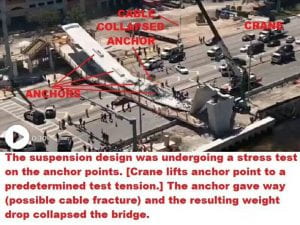NOTE: Picture from an unknown source from the social media. National Transportation Safety Board (NTSB) will investigate the collapse and draw conclusion after the investigation. My post is a pure speculation, hopefully attracting attention to my research pages. Neither I nor UWM is responsible for the possible mistakes in this post!
First of all, “ANCHOR” is mentioned in the picture, and my research is about concrete anchors (http://nees-anchor.ceas.uwm.edu/). The anchor here may not be the ones subjected to my study; however, they should serve a similar purpose: to attache steel components to concrete.
The suspension bridge has multiple anchor points for steel cables. The bridge may be safe when supported by all these anchors. According to the picture, stress tests were being conducted to ONE anchor point when the bridge collapsed. My speculation is that the bridge, designed as a continuous beam with multiple supports, became a cantilever beam under the one point loading. The bridge cracked at the anchor point during the stress test.
This next part is related to my research at UWM: the tensile capacity of concrete anchors can significantly decrease when cracks form near or passing the anchors. Anchor reinforcement should be properly designed and provided in this case. Our research (http://nees-anchor.ceas.uwm.edu/Research_activities_Phase_V.html) has proposed and verified a method for engineers to consider when designing reinforcement in concrete around concrete anchors. The proposed method specifically work for potentially cracked concrete, maybe seen in this incident.
Out thoughts and prayers are with those hurt in the accident and the local community. We look forward to NTSB’s report.
